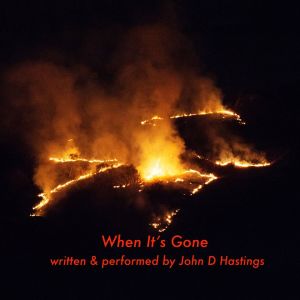Dear Followers,
 We’re proud to have a fund-raising partnership with John D Hastings Music. You can help!
We’re proud to have a fund-raising partnership with John D Hastings Music. You can help!
John D Hastings is a singer, songwriter, lyricist – a working-class lad from a small industrial town called Eston, North Yorkshire and proud of it.
 The fundraising song, When It’s Gone was launched on World Environment Day in June 2020. Proceeds from the moving song, from as little as £2 or bigger song bundles, are being donated to Cleveland Archaeology Trust (CAT) for ongoing community work in the ICE AND FIRE rescue project which began in 2017. You can listen to a short taster on the song webpage.
The fundraising song, When It’s Gone was launched on World Environment Day in June 2020. Proceeds from the moving song, from as little as £2 or bigger song bundles, are being donated to Cleveland Archaeology Trust (CAT) for ongoing community work in the ICE AND FIRE rescue project which began in 2017. You can listen to a short taster on the song webpage.
Never in history have we needed to care more for our natural landscapes and promote CAT’s mission of “Connecting People With Place by promoting well-being, belonging and cultural value through sustainable Heritage and Archaeology.”
 Eston Hills are being ravaged by arson attacks and damaged by vandals. John writes “I grew up there and community group Friends of Eston Hills bought the land back for future generations to enjoy. The senseless destruction of important heritage sites and natural beauty inspired me to write this song. I want to empower people to band together, stand up for their environment when it’s under threat. Let’s use music as a positive and non-violent way to drive out this brutal anti-social behaviour. Before it’s too late.”
Eston Hills are being ravaged by arson attacks and damaged by vandals. John writes “I grew up there and community group Friends of Eston Hills bought the land back for future generations to enjoy. The senseless destruction of important heritage sites and natural beauty inspired me to write this song. I want to empower people to band together, stand up for their environment when it’s under threat. Let’s use music as a positive and non-violent way to drive out this brutal anti-social behaviour. Before it’s too late.”
Donations will help us:
- Provide community engagement for all: kids, parents, schools, walkers, dog walkers and their dogs, cyclists and more
- Do more to protect our landscape, to preserve it for future generations
- Continue to explore, discover, rescue and repair before our heritage is lost
- We will report back, and we will celebrate a unique part of Britain!
- Everybody in any part of Britain and the world can get involved – that’s our partnership mission
 Please help us spread the word! If you would like to donate a larger sum, please get in touch.
Please help us spread the word! If you would like to donate a larger sum, please get in touch.
Kind Regards,
Managing Director







 In a great start to 2020, Cleveland Archaeology Trust is registered in England & Wales as a Community Interest Company (CIC) no. 12441367. We now also have a business bank account, three directors including my colleagues Paul Docherty & Guy Forster, and a fantastic team of specialist advisors. We’re ready to make funding grant applications and seek donations for ongoing community projects in our patch of north-east England, hopefully continuing later in the year, after three amazing years of evaluations. See what we’re up to at
In a great start to 2020, Cleveland Archaeology Trust is registered in England & Wales as a Community Interest Company (CIC) no. 12441367. We now also have a business bank account, three directors including my colleagues Paul Docherty & Guy Forster, and a fantastic team of specialist advisors. We’re ready to make funding grant applications and seek donations for ongoing community projects in our patch of north-east England, hopefully continuing later in the year, after three amazing years of evaluations. See what we’re up to at 



 ZAP! Science and lasers
ZAP! Science and lasers The results were compared to over 1200 analyses of geological samples from 21 bedrock sites from across the Chalk, as well as 14 sites that sampled a range of superficial deposits, such as river terrace gravels and glacial tills, centred on the Severn Valley and Estuary.
The results were compared to over 1200 analyses of geological samples from 21 bedrock sites from across the Chalk, as well as 14 sites that sampled a range of superficial deposits, such as river terrace gravels and glacial tills, centred on the Severn Valley and Estuary.